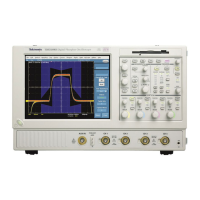52
Using a Second Monitor
—the convenience of a built-in PC
To optimize your access to the PC that is built into the oscilloscope, connect a keyboard, mouse,
and monitor to the side panel of the instrument, and then configure Windows for dual-display
mode.
In this configuration, the oscilloscope retains full dynamic oscilloscope performance while
Windows and other applications such as publishing, analysis, or Web browsing tools reside on the
external monitor. You can copy/paste bitmaps and waveform data from the oscilloscope to the
locally running application or view Web-based reference information while using the oscilloscope
for design work.
You can also drag up to five dockable HSCWs (half-screen control windows) from the TekScope
application onto the display of the second monitor. For example, this feature allows you to have
the Horizontal/Acquisition, the Horizontal Zoom, and the Display Setup Control Windows (half
screen) open on the second monitor at the same time. In addition to the five dockable windows on
the second monitor, you can have one dockable window open on the main display. If you open a
seventh dockable window, the window that has not been used for the longest amount of time will
automatically close.
To drag an HSCW window, click and drag on the left edge of the window.
Connecting to Other Instruments
—useful connections to other instruments
The oscilloscope provides four signal inputs and outputs that you can connect to other
instrumentation:
Use the rear-panel vertical signal output (SIGNAL OUT) to connect to a buffered version of
the signal that is attached to the Channel 3 input (4-channel models only). The typical output
amplitude is 50 mV/div 20% into a 1 MΩ load, or 25 mV/div ±20% into a 50 Ω load
Use the rear-panel auxiliary output (AUX OUT) to obtain a TTL-compatible, negative
polarity pulse when the oscilloscope triggers.
Use the rear-panel external reference input (EXT REF) to synchronize the oscilloscope time
base to an external 9.8 10.2 MHz reference frequency source. The reference input voltage
range is 200 mV p-p to 7V p-p.
The trigger level range for the front-panel auxiliary input (AUX IN) is adjustable from +8 V
to –8 V. The maximum input voltage is ±20 V.

